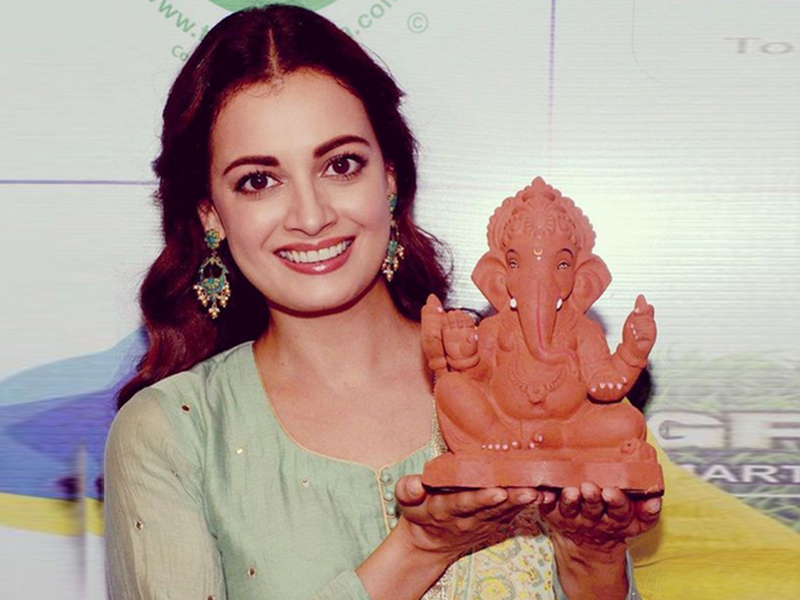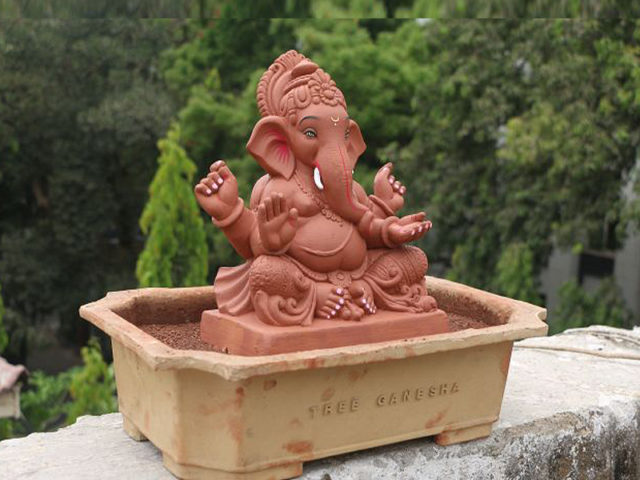One of the most significant and fun festivals, Ganesh Chaturthi, is celebrated with smiling faces and great enthusiasm in India. This year, families will open their homes and invite Bappa and devote themselves to the Vighnaharta on 10th September. If you bring Lord Ganesh’s idol into your house every year you must already be in planning mode, all set to go. But wait, have you thought about switching to an eco-friendly idol to ensure that we take care of the planet Lord Ganesh blessed us with? Making this change is the need of the hour and celebrating the festival in a sustainable way. If you want to know how to choose the right eco-friendly murti, here are some tips that can help you. Here are some hacks for mandap decoration for Ganpati at home. Check it out here.
On Ganesh Chaturthi, enjoy the happy vibes and the delicious food. Check out here some classic recipes you definitely want to try!
Bringing Home Eco-Friendly Bappa
1. Eco-Friendly Murtis Are Heavier
Eco-friendly murtis are heavier because they are made from natural soil and not Plaster Of Paris. This is the easiest way to recognise a natural Ganesha idol. To not be fooled, you must check the weight of the idol twice as some sellers fill a P.O.P. mould with cement just to increase the weight of the murti. You can get it from a trusted seller too to avoid this hassle.
2. The Price Difference Isn’t Huge
The emotional attachment to the Bappa’s murti that we welcome in our homes is unmatchable. But due to budget restraints, we often look for what’s nicer and cheaper. Due to a lack of awareness about the benefits of an eco-friendly Ganesha idol, we tend to go for P.O.P. idols rather than eco-friendly ones because they’re cheap. In reality, the price difference between a P.O.P. murti and an eco-friendly murti is not that huge anyway.
3. Avoid Idols Decorated With Diamond Stones
If the murti is decorated with diamond stones that means it is not eco-friendly. These decorative stones that are actually made from plastic can do harm to aquatic life if the visarjan is traditional. The decoration can be the first indication of the murti not being eco-friendly.
4. Say No To Harmful Colours
We love colours and if we keep the aesthetic perspective in mind, colours create a great visual appeal. However, they are not so great for the environment as they are made from lead, aluminium and copper. These substances once dissolved in water can form toxins which lead to the destruction of aquatic life. No eco-friendly murti will have glossy shiny colours.
5. Steer Clear Of Hollow Murtis
As plaster murtis take more time to dissolve in the water, they become hollow. This hollowness then leads to the fish getting stuck inside and dying. This is why it’s crucial to opt for a murti that doesn’t harm nature.
Step-By-Step Guide To Performing A Home Visarjan
Ganesha Visarjan varies from one family to another depending on their traditions. For all of you who’ll do it during Ananta Chaturdashi, here are the following steps usually followed.
- On the day of Bappa’s visarjan, the entire family gathers around in front of the idol and offers their final prayers.
- This is usually done by offering flowers, lighting diyas, incense sticks, modaks, ladoos and other eatables which were prepared earlier for the day.
- The aarti is done with the ritualistic camphor flame in the puja thali.
- The whole family chants prayers and the head of the family sprinkles vermillion-laced rice called Akshad on the idol. Everyone does a final namaskar.
- Finally, the eldest member of the family touches the idol and gently moves it as a mark of starting the farewell journey.
- You must offer him curd and sweets as you bid him farewell. Also, your family must bundle some rice and cereals in a red cloth to accompany him during his voyage back home.
- The various shlokas of Ganesha are chanted. Then, the designated eldest member takes the idol for a final round around the house.
- Usually, a bucket is used where the eco-friendly idol gets immersed and this is how Ganesha Chaturthi celebrations come to an end.
- The water should then be properly disposed of. Since nowadays most of the murtis used are made of clay, once the idol gets properly immersed and breaks down, remove any form of plastic jewellery or thermocol that may have been used as adornments on the idol. All that the bucket must contain are water and clay. This can be used to water outdoor plants in your garden or even your terrace. If your space is limited and you don’t have plants around you, make sure to water any roadside tree with the water. Don’t let the water flow across drains when good use can be made out of it.
- Any form of plastic jewellery can be reused for the next year. You can even DIY jewellery pieces for Bappa using bits and pieces from last year.
- If your Ganesha murti is made out of Plaster Of Paris and chemical paints are used, make sure you dispose of the water to the municipal/local authority waste bins so that they can be taken care of and filtered accordingly. Remember to let them know that the water is unfit to be discharged in any nearby water bodies.

Now you know everything you need to do for celebrating Ganesh Chaturthi responsibly. Change in the way we celebrate special events is vital to keep the Earth free from pollutants. One thing that can be done the traditional way is to eat a lot of modaks! Share your eco-friendly Ganesh Chaturthi stories in the comments section.







